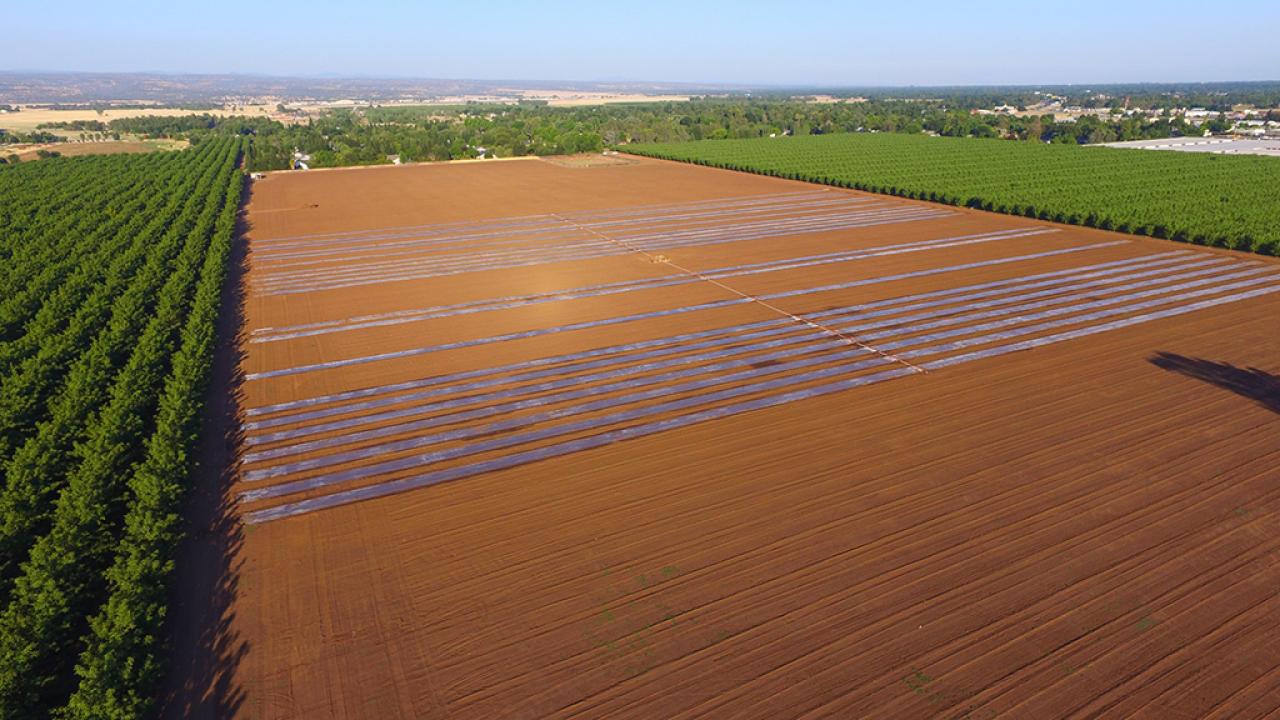Farmers spend a lot of time and money controlling weeds and other pests, and often have to turn to chemical fumigants to keep the most destructive pests at bay. Farmers also wrestle with what to do with low-value byproducts of crop production, such as skin, seeds and hulls from fruit, vegetable and nut processing.
What if those agricultural waste streams could generate alternatives to chemical fumigants and make farming more productive, profitable and environmentally friendly?
Maybe they can. Researchers at the University of California, Davis, are encouraged by early results from collaborative experiments with “biosolarization,” a process that combines the sun’s heat with soil amendments to manage weeds and other soil-borne pests.
“It looks promising,” said food science and technology professor Christopher Simmons, who is testing biosolarization with various crops and working with farmers throughout the state. “We still have a lot of work to do, but biosolarization is showing real potential as a safe, sustainable way to control pests while improving crop quality and yield.”
Strengthening solar power
Many backyard gardeners know the power of solarization. When you lay a clear plastic tarp over moist soil, you can trap solar radiation and heat the soil enough to kill weeds and other soil-borne pests. It’s effective, but can take four to six weeks, which is often too long for commercial fields to lay fallow.
Biosolarization can accelerate and improve the process. Simmons and his team are adding organic amendments such as grape and tomato skins or ground nut hulls to the soil before they tarp it, which promotes growth of beneficial bacteria. The helpful microorganisms compete with pests and temporarily make the soil more acidic and therefore less hospitable to weeds and other pests.
Together, the soil-heating and microbial activity can reduce the treatment time to days, not weeks.
“And by activating beneficial microbes in the soil, biosolarization has the potential to improve soil health over the long term,” Simmons explained.
Testing under commercial conditions
Chemical fumigants are expensive, and many have been identified as carcinogenic by state and federal regulatory agencies. But when it comes to killing soil-borne pests, they are very effective.
“Fumigants are broadly biocidal, meaning they affect beneficial microorganisms along with the pests,” Simmons said. “Biosolarization allows more innocuous and beneficial microorganisms to persist in the soil.”
But for farmers to adopt biosolarization as an alternative to chemical fumigants, the treatment must be effective, predictable and economical. So the team is testing biosolarization with a wide variety of crops, amendments and soils against different pests in various locations at commercial scale throughout the state.
“We have field trials underway with lettuce, tomatoes, melons and various cover crops,” Simmons said. “And we have a long-term, 10-acre trial with almonds at a conventional orchard in Chico.”
In Chico, Simmons and his team are collaborating with almond grower Rory Crowley at Nicolaus Nut Company with funding support from the Almond Board of California and the Western Center for Agricultural Health and Safety. They are one year into a 25-year experiment to see if almond-processing residues and the sun can boost soil health and reduce weeds and other soil-borne pests. So far, Crowley is impressed.
“It’s been great for the soil,” Crowley said. “Using biosolarization and a mustard cover crop, we’ve increased organic matter by 1.25 to 1.75 percent, which is a huge jump. That’s good for carbon sequestration and the overall health of the soil.”
It’s too soon to tell if the soil improvements will translate to greater crop yield, but Crowley thinks biosolarization could become a good pest-management tool and a valuable use for what would otherwise be agricultural waste.
“We need to find a home for the co-products of almond processing, so why not see if we can use them to improve soil health while controlling pests?” Crowley asks.
Field tests continue
Simmons and his team are testing biosolarization on several annual and cover crops in plots on the UC Davis campus using agricultural waste streams from tomato and wine processing. Soon they will begin tests with strawberries, which are commonly treated with fumigants each season as farmers plant berries anew.
Simmons’ hope is to demonstrate to farmers that biosolarization can be effective and economical under a wide range of conditions against a broad number of pests.
“We’re making significant ground,” he said. “We’re hopeful biosolarization can help farmers return food and agricultural waste back into the system to control pests and improve crop production.”
Media Resources
Amy Quinton, News and Media Relations, 530-752-9843, amquinton@ucdavis.edu
Diane Nelson, College of Agricultural and Environmental Sciences, 530-752-1969, denelson@ucdavis.edu
Chris Simmons, Food Science and Technology, 530-752-2109, cwsimmons@ucdavis.edu
